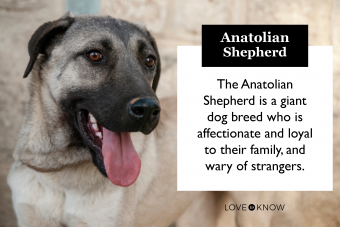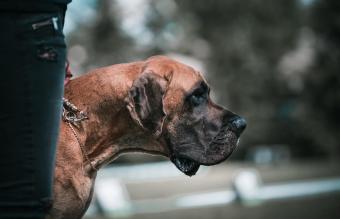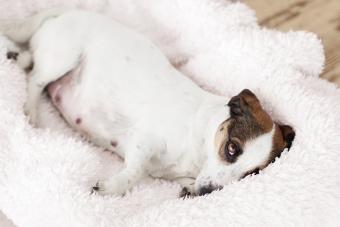
The Anatolian Shepherd is a loyal guard dog with love and affection to offer their family. Members of the breed are confident and very independent, but are also intelligent and loyal companions. They will capture you with their large size and giant teddy-bear like appearance.
Origin and History
The Anatolian Shepherd originated in Turkey, where the breed's ancestors served as shepherd's companions and livestock guardians. They were developed to resemble the size and color of livestock, explaining their large stature. The working ancestors of the breed are thought to date back approximately 6,000 years, marking the Anatolian lineage as one of the oldest among domesticated canines. Sighthound breeds are said to be responsible for their agility and aloof demeanor.
Anatolian Shepherds were introduced to the United States in the 1970s. Prior to their official arrival, the United States Department of Agriculture (USDA) embarked on a secret project to determine the best herding dog breed. A Turkish ambassador provided the USDA with two members of the breed as a gift for the experiment, but the female arrived pregnant, and also had a parasitic infection. The project proved to be too costly to maintain -- the Anatolians were reportedly extremely good eaters -- and was shut down, while the dogs were sold to a buyer at auction. Their fate remains unknown.
In 1970, when the breed was more formally introduced to the United States, the Anatolian Shepherd Dog Club of America was formed by a naval officer named Robert Ballard. In 1996, the breed entered the American Kennel Club (AKC) registry in the Miscellaneous class, but quickly moved to the Working Group in 1998.
Breed Characteristics
Experienced dog owners desiring a loyal and affectionate guardian are often interested in this breed. Keep in mind, however, that Anatolian Shepherds are famous for being independent and strong-willed. Take this into account if you are considering adding a member of the breed to your home.

Appearance
The Anatolian Shepherd Dog has a short coat with a thick undercoat. Feathers can be found on the ears, legs, and tail. Their coat color varies in a variety of hues, including:
- Pinto
- White
- Brindle
- Black mask
Males are between 110 and 150 pounds and stand 29 inches tall at the shoulder. Females are between 80 and 120 pounds and stand 27 inches tall.
Temperament
The Anatolian Shepherd is highly intelligent, independent, and hard-working. They are known to think for themselves, like many other guard dogs. They're protective of their family and are always on the lookout for intruders, whether animal or human.
Despite their protective nature, they are known to be calm, affectionate, and friendly with their families. They're weary of and often not friendly to strangers, and tend to be a bit reserved with those outside of their normal social circle.
When they're young, Anatolian Shepherds, like all dogs, require early socialization and exposure to a variety of people, sights, sounds, and experiences. Socialization is important for your Anatolian Shepherd puppy's development as a well-rounded adult dog.

Training
Anatolian Shepherds are highly trainable, but due to their independence and a stubborn streak, they're more inclined to evaluate whether or not to obey an order. They need an owner that is strong, kind, and consistent in their commands.
It's vital that the Anatolian Shepherd is properly socialized and trained so that they can understand what's normal and what's not permitted, particularly due to their large size. Anatolian Shepherds who haven't been properly trained or socialized might become overprotective, aggressive, and unmanageable. When properly socialized, this breed can be a special part of your family.
Exercise Requirements
The Anatolian Shepherd should have plenty of room to roam and is therefore not recommended for apartment-style living. They don't have a ton of pent-up energy but enjoy wandering around the property keeping watch. They average 45 to 60 minutes per day roaming. If you do want to take your dog for a walk, outdoor adventures like hiking are recommended.

Health
Anatolian Shepherds are typically healthy. However, they are susceptible to some health issues, as are all breeds.
- Hip dysplasia: A genetic condition that causes the thighbone to not fit properly into the hip. This condition often results in lameness in the rear legs and pain or discomfort.
- Demodectic mange: This condition is caused by the Demodex mite and is often passed from mother to offspring.
- Hypothyroidism: A disorder within the thyroid gland often managed with medication.
- Entropion: The inner eyelid begins to fold inward, sometimes necessitating surgical intervention.
Lifespan
The Anatolian Shepherd is a generally healthy breed with a lifespan longer than most large dogs, ranging from 10 to 13 years.
Grooming
Because the Anatolian Shepherd is inherently clean, grooming them isn't a major task. The breed's short coat requires little grooming, but expect a lot of shedding throughout the year. Brushing more frequently during those periods aids in the removal of dead hair. Bathing only three or four times a year is all that is required.
Brush your Anatolian Shepherd's teeth at least twice or three times a week to get rid of tartar and bacteria and maintain their oral health. Brushing your dog's teeth on a daily basis is even better to prevent periodontal disease if your dog will allow it. If your dog's nails don't wear down naturally, trim them once or twice a month to avoid unpleasant tears and other issues.
Fun Facts About the Breed
Little is known about the rare Anatolian Shepherd, but here are some interesting facts you should know:
- Since 1994, Anatolian Shepherds have aided in the conservation of cheetahs in Namibia.
- Anatolian Shepherds have appeared in several movies, including Kate and Leopold, and Friends With Benefits.
- The Anatolian Shepherd is also known as the Karabash Dog, Coban Kopegi, or Kara bas.
- In 2018, fires were raging in California, yet an Anatolian Shepherd guarded his burned-up home for an entire month, refusing rescue until his owners were able to return to him.
- Kurt, the world's tallest Anatolian, stood 40 inches tall at the withers and weighed 154 pounds, just 4 inches shorter than Zeus, the Great Dane who claims the title of World's Largest Dog.
Purchasing or Adopting an Anatolian Shepherd
If you're looking for an Anatolian Shepherd puppy, a good place to start is with the Anatolian Shepherd Club of America. The club has a breeder directory available as well as helpful tips on how to find responsible breeders with quality dogs. The AKC Marketplace page also has a breeder search. Expect to pay around $900 to $1,200, although higher-end show dogs from champion lines can cost as much as $5,000.

Rescue Organizations
While the Anatolian Shepherd is a rare breed, these dogs frequently end up in shelters because their owners are often overwhelmed by their requirements. To start, you can search the directories on Save-a-Rescue and Petfinder. You can also look at the following breed-specific rescue organizations:
- National Anatolian Shepherd Rescue Network: The National Anatolian Shepherd Rescue Network is a national effort to pull Anatolian Shepherds and mixes out of shelters and place them into foster homes, then onto their forever home.
- Blue Bonnet Animal Rescue: A non-profit rescue organization dedicated to finding homes for Anatolian Shepherds and other large-breed dogs.
- Shenandoah Shepherd Rescue: An organization rescuing Anatolian Shepherds and mixes, as well as other Shepherd breeds, and finding forever homes.
Is this the Right Breed for You?
The Anatolian Shepherd is not suitable for everyone. They can be loyal, loving companions if you and your family are aware of their special characteristics and requirements and are willing to accept the responsibility of owning a large, protective guard dog.







